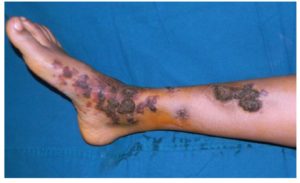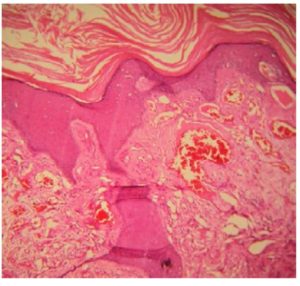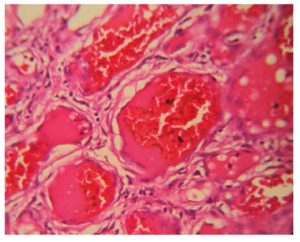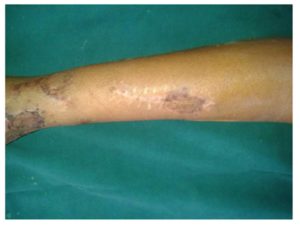Introduction
Verrucous hemangioma is a rare vascular malformation which presents at birth or in childhood as asymptomatic bluish-red soft papules, plaques, and nodules over legs, which become verrucous later in life. Recurrent bleeding and secondary infections are common. [1] Lesions may measure up to 8 cm in diameter. Linear verrucous haemangioma is even rarer with a few published reports. [4, 5, 6] Here we are presenting giant verrucous haemangioma with linear features successfully treated with excision and grafting.
Case Report
A 23 year old female patient presented to us with history of raised lesions over her right leg. On enquiry, these lesions were present since birth. Initially, started as pink patches and gradually progressed to become raised lesions. The lesions started to increase in the size and associated with pain since a year for which she came seeking for treatment. On examination, multiple skin coloured to hyperpigmented verrucous papules and plaques of varying sizes, arranged in a linear fashion noted over anteromedial and anterior aspect of middle 1/3rd of right leg extending up to the dorsum and sole of foot. One of the verrucous plaques was measuring more than 10 cm along the long axis [Fig 1]. Histopathological examination from one of the representative specimen showed compact hyperkeratosis, acanthosis and numerous ectatic vascular channels filled with red blood cells in the upper and mid dermis extending up to lower dermis [Fig2, Fig 3, ]. With this, a diagnosis of verrucous haemangioma was arrived at… Magnetic resonance angiogram (MR angiogram) of the right leg was done to delineate the depth of involvement. Since, there were no musculoskeletal and deep vascular connections; a planned excision of lesions with subsequent skin grafting was done in multiple stages [Fig 4].
Discussion
Verrucous hemangioma is a rare vascular malformation that presents either at birth or in childhood as bluish-red soft papules, plaques, and nodules over legs, which become verrucous later in life, or following trauma. Lesions may measure up to 8 cm in diameter. [1] In our case one plaque was measuring more than 10cm in diameter. Halter coined the term verrucous hemangioma in 1937, but Imperial and Helwig described it in detail. [2] The involvement is usually unilateral, but a solitary case report of bilateral involvement has been reported.[3] Linear or serpiginous forms are rare with a few published reports.[4,5] The characteristichistopathological findings are the presence of ectatic vessels with an overlying hyperkeratotic and acanthotic epidermis. Because of the paucity of reports of linear verrucous hemangioma, it is not certain whether the distribution corresponds to the lines of Blaschko. Nevertheless, linear forms reflect genetic mosaicism, and it is appropriate to consider it as verrucous haemangioma with linear expression, rather than linear verrucous haemangioma [6]. The clinical differential diagnosis includes angiokeratoma, angioma serpiginosum, lymphangioama and pigmented tumours.[7] Recurrent bleeding and infection along with increase in size of the lesions following trauma are the usual complications.[8] This condition is usually asymptomatic, but the cosmetic appearance makes them feel embarrassed and seek treatment. Since our case was a female patient about to get married, we planned for complete excision and grafting. As though, there are many modalities of treatment for this condition like, cautery, lasers, cryotherapy which result in recurrence; surgical excision is the treatment of choice due to its deep extension. [6,7]
Conclusion
This case is being highlighted for its unusual giant, linear presentation and successful treatment with excision and grafting.
Reference
1. Moss C, Shahidullah H [2010]. Naevi and other developmental defects. In: Rook’s text book of dermatology. Eds: Burns T, Breathnach S, Cox N, Griffiths C, 8th edn, Wiley-Blackwell 18.1-18.107
Publisher – Google Scholar
2. Imperial R, Helwig EB [1967]. Verrucous hemangioma: a clinicopathologic study of 21 cases. Arch Dermatol 96:247-253
Publisher – Google Scholar
3. Cruces MJ, De La Torre C [1995]. multiple eruptive verrucous hemangiomas: a variant of multiple hemangiomatosis.Dermatologica 171:106-111
Publisher – Google Scholar
4. Hayashi H, Shimizu T, Nakamura H, Shimizu H [2004]. Linear verrucous haemangioma on the abdomen Acta Derm Venereol 84:79-80
Publisher – Google Scholar
5. Klein JA, Barr RA [1985]. Verrucous hemangioma. Paediatr Dermatol 2:191-193
Publisher – Google Scholar
6. Wentscher U, Happle R [2000]. Linear verrucous hemangioma JAAD 42:516-519
Google Scholar
7. Kaliyadan F, Dharmarathnam, AD, Jayasree MG, Sreekanth G [2009]. Linear verrucous hemangioma DOJ 15(5):15
Google Scholar
8. Jain VK, Aggrawal K, Jain S [2008]. Linear verrucous hemangioma on the leg. IJDVL74:656-658
Google Scholar







